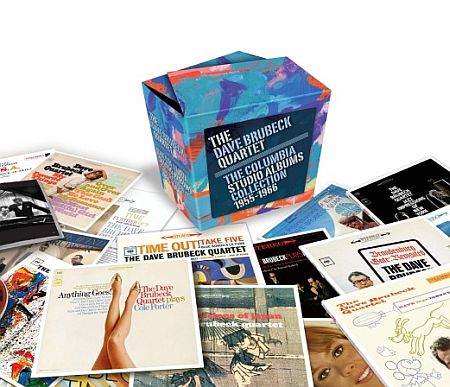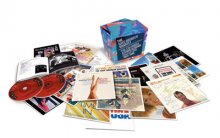
.jpg)

The Dave Brubeck Quartet, The Complete Columbia Studio albums collection
Label: Sony Music Entertainment
Year: 2011
Released on LP: No
Released on CD: Yes
Tracks
1. Brubeck Time (1955)
2. Jazz Impressions Of The U.S.A. (1956, first time on CD in U.S.)
3. Jazz Impressions Of Eurasia (1958)
4. Dave Digs Disney (1957)
5. Gone With The Wind (1959)
6. Time Out! (1959)
7. Southern Scene (1960, first time on CD in U.S.)
8. Bernstein Plays Brubeck Plays Bernstein (1961, including for the first time on CD in U.S., "Dialogue For Jazz Combo And Orchestra" with New York Philharmonic conducted by Leonard Bernstein)
9. Time Further Out (1961)
10. Countdown: Time In Outer Space (1962)
11. Bossa Nova U.S.A. (1963, first time on CD in U.S.)
12. Brandenburg Gate: Revisited (1963)
13. Time Changes (1964)
14. Jazz Impressions Of Japan (1964)
15. Jazz Impressions Of New York (1965)
16. Angel Eyes (1965, first time on CD in U.S.)
17. My Favorite Things (1966, first time on CD in U.S.)
18. Time In (1966)
19. Plays Cole Porter - Anything Goes! (1967, first time on CD in U.S.)
Notes
Sony in 2011 released newly assembled and affordably priced jazz titles under "The Complete Albums Box set Series" which they made available through their PopMarket.com website.
In Dave Brubeck's case they issued all the studio albums issued by Columbia in the period 1955 - 1967.
Nine of the titles are making their debut appearance on CD in the U.S. with this box set. They previously were only available in Japan in mini lp format under the "Sony Mastersound" series.
Sony stated that "Each multi-disc box set contains the artist's entire album output during their Columbia or RCA tenure, or focuses on some aspect of it. Each album is packaged in a replica mini-LP sleeve reproducing that LP's original front and back cover artwork. Where applicable, the albums in each box include the bonus tracks that have been released on the expanded CD editions over the years."
From Sony Music - www.popmarket.com
The 17 core years that Dave Brubeck spent at Columbia Records (from 1953 to 1970), saw this complex musician and compassionate bandleader develop into a multi-talented composer, arranger, producer, conductor, orchestrator, and ultimately a father figure for at least two generations of third through fifth stream jazz players.
The Dave Brubeck Quartet, in its early lineup (with alto saxophonist Paul Desmond, drummer Joe Dodge, and a succession of bassists) was signed to Columbia in 1953, by the renowned George Avakian. He followed the pianist's early lead (of live concert recordings on Fantasy) and also recorded him live for his Columbia debut. But this 19-album box set focuses on the Quartet's studio LPs, which actually began with their second album, Brubeck Time (1954).
The so-called 'classic' Dave Brubeck Quartet took shape with the entrance of drummer Joe Morello in 1956 and bassist Eugene Wright in 1958. They staked their claim to jazz immortality in 1959 with the Time Out album, the first million-selling LP in jazz history, featuring the single that changed all the rules, "Take Five" b/w "Blue Rondo A La Turk." There are stories and backgrounds to be told of every Brubeck Columbia LP, for example, 1961's Brandenburg Gate: Revisited, with its 10-part, 20-minute title suite, written by Dave and orchestrated and conducted by his brother Howard, a follow-up to their 1960 Leonard Bernstein project. Likewise, the Quartet's "Jazz Impressions" series - Jazz Impressions Of The U.S.A. (1957), Jazz Impressions Of Eurasia (1958), Jazz Impressions Of Japan (1964), and Jazz Impressions Of New York (1965). The Quartet was disbanded in 1967, the year of their final Columbia studio LP, The Dave Brubeck Quartet Plays Cole Porter - Anything Goes!, a swingin' affair.
Reviews
The Dave Brubeck Quartet: The Columbia Studio Albums Collection 1955-1966
By Matthew Fiander 9 March 2012
PopMatters Associate Music Editor - Copyright
2011 marked Dave Brubeck’s 91st birthday, and in celebration of his deep influence, and the lasting impact of his music, Columbia recently put out Their Last Time Out, a recording of the final live performance by Brubeck’s classic quartet comprising Brubeck, Paul Desmond, Joe Morello, and Eugene Wright. The performance proved both the staying power of the set’s classic tunes and the energy and chemistry the quartet had right up to the end.
As a celebration of Brubeck’s legacy, however, that was merely the tip of the iceberg. Columbia has now trucked out The Columbia Studio Albums Collection 1955-1966, a massive, 19-disc set of Brubeck’s entire output for the label. If the idea seems ostentatious, even overstuffed, the music itself is not. The 19 albums here are both remarkably consistent in quality and dynamic and surprising in their shifts in tone and mood and composition and, of course, tempo.
This may seem like a boxed set meant only for the ultimate Brubeck fan—one who might already have all this music, which makes one wonder who might buy this thing—but the price tag aside, this is essential listening for anyone interested in jazz music. There are the unsurprising greats here—Time Out still stuns with every listen, as does its sequel Time Further Out and the classic quartet’s swan song, the lively Plays Cole Porter—Anything Goes!—but what makes this collection vital are the hidden, or perhaps forgotten gems that stick out of the bunch.
Chief among these are some of the albums here available for the first time in the U.S. on CD. Half of these records have never been available on compact disc, and to have them all collected here is to see what we may have been missing stateside—though of course, many fans probably purchased them on vinyl. Still, a record like 1959’s Southern Scene stands out even when mixed among better known albums. The release achieves an impressive feat in taking traditional music from the south—folk music and, in particular the melodies of Stephen Foster—and morphing them into jazz numbers. The results, from their lively take on “Oh Susanna” to open the record to the understated shuffle of “Darling Nellie Gray”, are stunning. The interplay of Desmond’s lyrical horn fills with Brubeck’s unpredictable piano phrasings is no surprise, considering that’s what they built their legend on, but the way these songs are coated in the dust of a new tradition, how they honor the past yet burst with a modern, innovative energy makes this album one of the unsung heroes of the collection.
After Brubeck disbanded the quartet in 1967, he would focus more on arranging and orchestral music, and you can hear him branching out in fascinating and fruitful ways during his Columbia tenure. 1960’s Bernstein Plays Brubeck Plays Bernstein is a brilliant document of this side of Brubeck’s talent as both musician and arranger. “Dialogue for Jazz Combo and Orchestra” has the quartet playing with the New York Philharmonic, conducted by Leonard Bernstein himself. It truly does sound like a conversation. Sometimes the quartet and the orchestra play together, building a grand synthesis of sounds, while in other places it’s more of a call and response, the orchestra clearing out to let Desmond vamp or Brubeck clang away before the quartet returns the favor. You can hear both Brubeck and Bernstein learning from and feeding off each other, twisting their singular styles in new and exciting ways to weave their musical visions together, so that the circularity of the album’s title is no mere smirk—it’s the sign of the true collaborative nature of the music contained on the album.
The album also marks another fruitful collaboration in Brubeck’s musical world, this one with his brother Howard. Howard arranged “Dialogue for Jazz Combo and Orchestra”, laying down the intricate pieces for the interplay between Dave Brubeck and Bernstein. Howard would also arrange and conduct the first, 18-minute-plus movement on the excellent Brandenburg Gate: Revisited, originally released in 1963. Like the Bernstein collaboration this weaves back and forth between orchestral flourish and the tight playing of the quartet, but the shifts in tempo and tone here are all over the map, surprising the listener with its ability to move from sweeping size to intimate solos, from bittersweet space to tight fervor, without ever going off track. If other jazz musicians struggled to keep the spontaneity and vision of their sound when they recorded with an orchestra—there were growing pains for the likes of Monk and Mingus, among others—Brubeck never once faltered. If we know him for innovative records like Time Out, he’s a legend for the work he does on lesser known but impressive records like Brandenburg Gate: Revisited.
As a progression, this collection shows Brubeck’s various interests and his growing talents as an arranger over his career. This set also shows the various threads he followed, simultaneously, over the course of his career. All Time records—Time Out, Time Further Out, Countdown: Time In Outer Space, Time Changes, and Time In—and each time you come across one, if you listen chronologically, it’s like coming back to a familiar story. He may go off and make a Bossa Nova record after Countdown, or record Brandenburg Gate: Revisited before Time Changes, but the Time records and their unique shifts remain tied together, an impressive progression from just one side of Brubeck’s many-faceted musical world. Similarly, the four Jazz Impressions records—of the USA, of Eurasia, of Japan, and of New York—feel like their own path woven among these other records. You can feel the different geographies and cultures working their way into the sound of those records, and you can see how Brubeck was as much driven by vision—by what he saw around him in the most inspiring places—as he was by sound.
This is a huge collection of albums, one that is a lot to take in even when you give yourself time to. But it’s also the kind of collection that will grow with you, that will constantly reveal another album’s impressive surprises. Dave Brubeck remains one of the titans of jazz music as we know it mostly because he challenged us to consider what we actually knew about jazz, and questioned if maybe there wasn’t room within it for other tempos, other textures, other sounds. This set—free of b-sides or extra takes, each album packaged in a sturdy facsimile of the original record sleeve—is a pure and honest representation of Brubeck’s most fruitful period and, even if it seems like an awful lot, it never sounds like too much. Beyond all the surprises and innovations and just plain powerful playing here, the one thing that will stun you is the consistency he delivers over more than a decade and 19 albums. For a guy so used to tapping out strange time signatures, it’s no small feat that he never missed a step.

